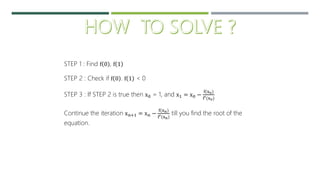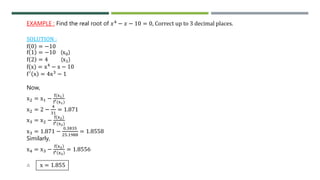Newton raphson method
- 1. MADE BY : MOHIT AGARWAL â 161080107026 COMPUTER â 4TH SEM
- 2. Let f(x)=0 be the given equation and x0 be an approximate root of the equation. If x1 = x0 + h be the exact root then f(x1)=0. i.e., f(x0 + h)=0 f(x0) + hfâē x0 + â2 2! fâēâē x0 + âŊ = 0 [By Taylor Series] Since h is small, neglecting â2 and higher powers of h, f x0 + hfâē x0 = 0 h = â f(x0) fâē(x0) âī x1 = x0 + h = x0 â f(x0) fâē(x0) Similarly, starting with x1, a still better approximation x2 is obtained. x2 = x1 â f(x1) fâē(x1) In general, x = x â f(xn)
- 3. STEP 1 : Find f 0 , f 1 STEP 2 : Check if f 0 . f 1 < 0 STEP 3 : If STEP 2 is true then x0 = 1, and x1 = x0 â f(x0) fâē(x0) Continue the iteration xn+1 = xn â f(xn) fâē(xn) till you find the root of the equation.
- 4. EXAMPLE : Find the real root of ðĨ4 â ðĨ â 10 = 0, Correct up to 3 decimal places. SOLUTION : f 0 = â10 f 1 = â10 (x0) f 2 = 4 (x1) f(x) = x4 â x â 10 fâē x = 4x3 â 1 Now, x2 = x1 â f(x1) fâē(x1) x2 = 2 â 4 31 = 1.871 x3 = x2 â f(x2) fâē(x2) x3 = 1.871 â 0.3835 25.1988 = 1.8558 Similarly, x4 = x3 â f x3 fâē x3 = 1.8556 âī x = 1.855


![Let f(x)=0 be the given equation and x0 be an approximate root of the
equation.
If x1 = x0 + h be the exact root then f(x1)=0.
i.e., f(x0 + h)=0
f(x0) + hfâē x0 +
â2
2!
fâēâē x0 + âŊ = 0 [By Taylor
Series]
Since h is small, neglecting â2
and higher powers of h,
f x0 + hfâē
x0 = 0
h = â
f(x0)
fâē(x0)
âī x1 = x0 + h = x0 â
f(x0)
fâē(x0)
Similarly, starting with x1, a still better approximation x2 is obtained.
x2 = x1 â
f(x1)
fâē(x1)
In general, x = x â
f(xn)](https://image.slidesharecdn.com/newtonraphsonmethod-180921082758/85/Newton-raphson-method-2-320.jpg)


